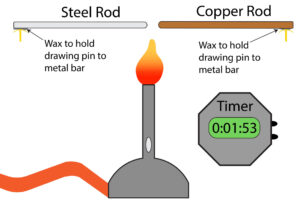AQA GCSE Conduction(Physics)
Conduction
Conduction is heat energy transfer through a solid.
Metals are poor insulators or good conductors of thermal energy.
Non metals are good insulators or poor conductors of thermal energy.
Thermal Conductivity Experiment

The bunsen burner is used to heat both the steel and the copper rods. Drawing pins are held to the metal bar by a small piece of wax.
As the thermal energy is conducted along the rods, the time taken for pins to fall is recorded.
Thermal Conductivity
Thermal conductivity is a measure of how quickly thermal energy can be conducted through a solid.
Good conductors such as metals have high thermal conductivity
Good insulators such as polystrene have low thermal conductivity
Improving Insulation
Improving insulation is important to reduce heat loss. There are several ways that heat loss can be reduced:
1.Use materials with low thermal conductivity
2. Increase the thickness of the insulating material
3. Decrease the temperature difference between the material inside the cup and outside. The hot drink will cool down slower in a warm room than outside in the winter.
Practice Questions
1.State the names of 3 conductors and 3 insulators
2. A manufacturing company is designing a new saucepan, should they use a material with a low or high thermal conductivity, explain your answer.
3. Describe how insulating ski wear is designed in order to reduce heat loss whilst being worn.
4. A cooking pot contains a stew at 90°C . Sam suggests that if the cooking pot is placed into a larger container of water, it will allow the stew to cool down faster to room temperature, than if it is allowed to cool just using air surrounding the cooking pot. Explain in terms of thermal conductivity why Sam is correct.
Absorption and Emission of EM Radiation
JJ Thomson and Plum pudding model
Ernest Rutherford and the Nuclear Model
Niels Bohr changing the Nuclear Model
Discovering the Proton and Neutron
Measuring radiation from radioactivity
Radiation types and properties
Random nature of radioactive decay
Radioactive contamination or irradiation
Hazards of contamination and irradiation
Studies on the effects of radiation on humans
Different half lives of radioactive isotopes
Nuclear Fission Chain Reaction
Writing nuclear fission equations
Drawing ray diagrams for a concave lens
Drawing Ray Diagram to produce a virtual image for a convex lens
Drawing ray diagram to produce a real image for a convex lens.
Specular and Diffuse Reflection
Seeing Coloured Objects Part 2
Viewing objects through coloured filters
Transparent, Translucent and Opaque